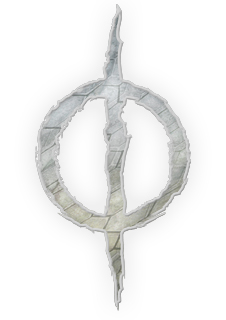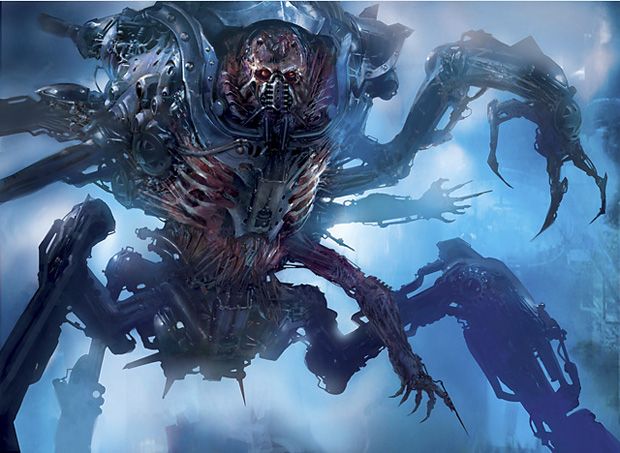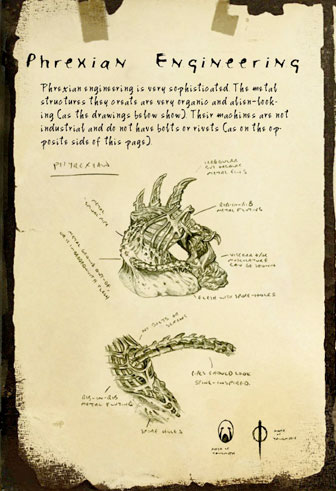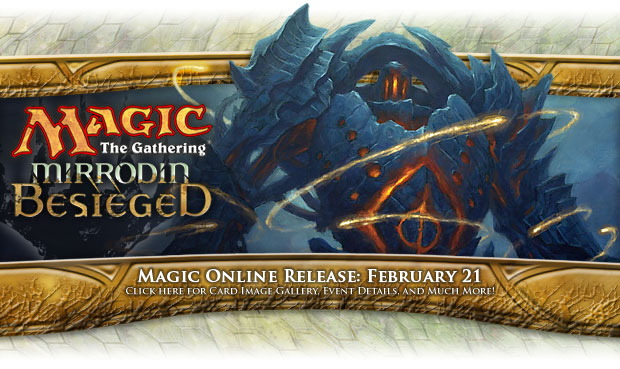Pick a Side, Any Side
Welcome to Pick a Side Week. We've asked all of you to pick a side in the Mirran-Phyrexian conflict, so this week all the columnists are going to do the same (or talk about how they went about making their choices). I'm been the most vocal advocate of the Phyrexians, so it's pretty clear I've already chosen my side. I choose Phyrexia.

Okay, 62 words in and I've already completed my assigned theme. Only 2700+ words to go. Perhaps, I should go into slightly more detail on why I'm choosing Phyrexia or, more accurately, why I've been Phyrexia's greatest cheerleader since the set first premiered. Note that in everything I'm going to say below, I am talking about myself and my opinion, not the opinion of Ramp;D or Wizards at large. Today is about me explaining why I, Mark Rosewater, have picked the Phyrexian side.
I'll be approaching the issue from two axes: mechanics and flavor.
- Mechanics
I'm a game designer, so the place I'm going to start is with the game mechanics of each side. Phyrexia has infect and proliferate. Mirrodin has metalcraft and imprint. If you want to include non-keyword, non-ability-word mechanics, Mirrodin also has indestructible (a.k.a darksteel) and charge counters. Let's examine each of these one at a time.
Infect – This examination is a subjective one and not an objective one. I'm talking about what I personally like. There is little in the game of Magic that excites me more than poison. Probably this is extremely tainted by my fifteen-year quest to make poison a major component of a set or block, but when I play any form of Scars of Mirrodin block Limited, I will play poison in every deck I can. For playtest purposes, I spent a lot of time in design playing other strategies to make sure I understood what else you can do with the set. My playing poison is not about being unaware what else I could do, but rather about doing what I enjoy.
Why do I like poison so much? I've always been a big fan of alternate win conditions. I feel the flavor is very strong. I like how it makes you play in a slightly different way from normal. I can give you all sorts of rational explanations, but the most important thing is it makes me happy when I play it. In the end, that is the most important thing a mechanic can do: connect with the player in a positive emotional way.
On top of that, I really like infect as a design. I have spent a lot of time trying to figure out how best to use poison, and infect is far and away the best execution I've ever been able to create with it. I feel it does a good job of making poison more interactive with the rest of Magic. In addition, I feel the "wither" component adds an extra layer to creature combat.
Is it the perfect mechanic? No. For next year's State of Design article I have to evaluate whether poison was successful in its implementation. The short early answer is that it is very polarizing. The majority really like it, but the minority that dislikes it dislikes it strongly. Is that a success? You'll have to wait for the State of the Design column for my thoughts on it. (I do want to get an entire year's worth of data to use when I draw my conclusions.)
If I have to rate infect on a scale of 1 to 10 with 1 being "hate it" and 10 being "love it," infect is, for me, clearly a 10—or, to borrow from Spinal Tap, it goes to 11.
Proliferate – In case I haven't made this point clear in numerous other columns, I am a Johnny. (If you don't know what I'm talking about, go read my most recent column on the psychographics of Magic.) I enjoy expressing myself through Magic by using my creativity to do my own thing. Because of that, I'm a big fan of open-ended mechanics. That is, I like mechanics that give me a lot of options how to use them. In Ramp;D we tend to refer to these as Johnny mechanics. By far the Johnniest mechanic in Scars of Mirrodin block is proliferate. (Proliferate has some Timmy and Spike appeal as well, but if you have to stick it in one psychographic, it's more Johnny than any other.)
I really enjoy proliferate's ability to do so many different things. Even in Scars Limited, proliferate can accomplish a variety of different tasks. I have a reputation for drafting repeatable proliferate cards very high, often first-pick, because I enjoy playing with them. I also like the kind of decks I draft when I take them early.
I'm clearly biased with proliferate as I designed it (along with Mark Globus), but it's very normal for designers to create mechanics that they like to play with. (One of the hardest design skills is learning to design things that aren't your style of play.) On my 1 to 10 scale, I put proliferate at about 8 and a half (what I like to call the Fellini rating—in-joke for my film-loving readers).
Metalcraft – This is what we call a threshold mechanic in Ramp;D. (I talk all about this in my column during Metalcraft Week, I Want to Threshold Your Hand (Or Possibly My Artifacts).) Threshold mechanics tend to lean a little more towards Spike as they are usually resource-management mechanics (manage your resources to make sure that you can have thing X happen). The linearity of metalcraft helps add some Timminess to it.
I think metalcraft is a very solid mechanic and I feel it does a good job of being a threshold mechanic. I like what it does for deck building, it allows cool individual cards to be made and it plays well. In design, I played a bunch of metalcraft decks as I was trying to figure out how best to make it work, so I do get how and where it shines. It's just not my personal cup of tea. It's not the kind of Magic that I gravitate to. For me (and once again, this is not an objective overview of the mechanic, just a personal rating about how I feel about it for me when I play Magic), metalcraft is about a 5.
Imprint – Imprint is one of my babies from the original Mirrodin block. In many ways it's not so much a mechanic as a mechanical tool to create cool individual cards. I like a lot of imprint cards and I definitely enjoy designing them, but it's something more enjoyed case by case than in its entirety. Also, as Scars of Mirrodin block shows, it's hard to design good imprint cards so we've opted to make fewer but stick to very cool ones.
It's a hard mechanic to grade as there are individual imprint cards that are easily 9s and 10s. The mechanic in its entirety gets a bit pulled down by the many that don't shine as brightly as the standout designs. I'd give it a 7 and a half.
Indestructible (Darksteel) – I'm not going to get into my ongoing quest to turn this into a keyword, but I will say I'm still fighting the good fight. I do like indestructible quite a bit as a mechanic (I had a whole column about it during Darksteel Week, The Darksteel Returns), so much so that I helped push it to become an evergreen mechanic (Ramp;D slang for something that we can use whenever we want, often appearing in every block). I like how Scars block is using it but the fact that it's become a mainstay keeps it from feeling as special as the other mechanics. If I was grading it for all of Magic, I'd give it an 8, but for creating excitement in Scars of Mirrodin block, it's closer to a 4. It was necessary and I'm glad we used it, but it doesn't do much to make the Mirrodin side more exciting for me.
Charge Counters – I do love me some counters (and tokens as well—it must be my love of little glass beads). When I play the Mirrodin side, this is the part that most draws me in. I enjoyed it when I put it in Mirrodin, and I enjoy it in Scars of Mirrodin. The only real strike against it for me is that metalcraft pulled some focus off of it, making development more willing to turn the knob down slightly on this subtheme.
The flavor of artifacts with limited uses is a compelling one to me and is something I plan to incorporate into artifact sets when it fits. I give it a grade of 8.
So when you average my scores together, Phyrexia has an average of 9.25, while Mirrodin has an average of 6.125. Phyrexia has two of my all-time top ten mechanics. The only Mirrodin mechanic with a shot at that list is imprint, and even then it's probably not in the top five.
- Flavor
Before I get into this section, let me make a few things clear. I am not involved with creating story. While I was involved in the world building of the original Mirrodon block, the only involvement I had with the creative team for Scars of Mirrodin block was to integrate the design with the chosen story and environment. I in no way had any influence on the ultimate outcome of the war. My job was to design the block to the already known outcome, not create it. What follows is my personal opinion about creative elements. Remember, my last job before being a game designer had a little something to do with making stories.

I'm not here to trash the Mirrans. I like the Mirrans. As I said above, I was directly involved in the world building of Mirrodin. I like the idea of an artificially created world that populates itself by trapping creatures from other planes. I also like the idea that Mirrodin evolves these creatures to start making metal an organic part of their bodies. The entire concept of Mirrodin is pretty cool. The issue at hand isn't whether I like the Mirrans; it's whether I like them more, story-wise, than I like the Phyrexians.
Remember that I am one of the historians of Magic. I've been part of the game since its beginning and have been actively part of shaping it for the last fifteen years. If I hadn't been one of the people designing Time Spiral, I would have been one of the players lapping it up. I love the history of the game. That is why the Phyrexians hold such a near and dear place in my heart. I feel like the Phyrexians are to Magic what Lex Luthor is to Superman or the Joker is to Batman. To me, the Phyrexians are the iconic villains of Magic.
Magic has only told a few big stories. The two biggest in my mind, in a historical context, are the Brothers' War (originally told through flavor text in Antiquities and later fleshed out in books) and the Weatherlight Saga (told from the set Weatherlight through Apocalypse as well as in books). The main villain in both these stories is the Phyrexians.

The Phyrexians also hit an archetype that fascinates me. Here's what I said about the archetype during Proliferate Week:
From a story standpoint, the Phyrexians are a horror archetype I call "The Plague." It is a race of usually foreign creatures that come and slowly turn you into them. Examples of this archetype would be the zombies from Dawn of the Dead, the pod creatures from Invasion of the Body Snatchers and the Borg from Star Trek. The daunting part of this archetype is that stopping them feels hopeless insomuch as each victory not only puts them up one but you down one. In addition, the idea that some monster turns you into a monster like them is pretty creepy.
As a story-telling venue, Magic is best when it is telling what I call environmental stories. That is, the best thing Magic can show off creatively is an environment. The genre of a trading card game requires that you show lots of creatures and places and objects. This does a good job of showing off a diverse environment.

The Weatherlight Saga was an attempt for us to tell a plot driven story through card sets. What we learned from that is that it's very hard when we can't control the order that players see the cards to convey traditional plotting. (If you haven't had a chance to see it, check out the plot-driven story of Tempest broken down in order. It's pretty cool, once it's all laid out for you.) What Magic is good at is telling stories about changes that happen on an environmental level. This way the changes aren't seen on a single card but a wide swath of cards. When we tell a story in another medium, we will tell a story that plays to that medium's strength. Card sets, though, have to tell stories that can be told through card sets.
One of the reasons that I believe the Phyrexians make a perfect villain is that they attack on an environmental level. Take Scars of Mirrodin as an example. The attack of the Phyrexians isn't something seen on a single card but on many, many cards, both in color and card type. My contention is that Magic's best villain is one that works in the kind of stories that Magic (the card sets) can tell.
Another important point about the Phyrexians is that they have a distinctive look all their own. The art is an integral part of the game and I think a key component of any Magic character is the ability to create strong visuals. I feel that the Phyrexians do that in a way that is compelling but also original to the game. While Magic has put its spin on many iconic fantasy creatures, the Phyrexians have the distinction of being one of the few things that is unique to Magic.

So the Phyrexian have historical context, archetypal resonance, and a strong visual look. In other words, they're pretty damn awesome. Note that I'm not knocking the Mirrans. I think they too have a lot going for them, but for what I'm interested in they can't compete in any of the three categories I just listed. In my mind, the Mirrans are pretty cool. I just think the Phyrexians are cooler.
- Knowledge of Good and Evil
The only sticking point for me with choosing the Phyrexians is that I tend to enjoy rooting for the good guys. I'm a long-time comic reader and I favor the heroes over the villains. I do enjoy watching good overcome evil so it is with some hesitance that I root for evil in this particular conflict.
The reason for this as I spent some time thinking about it is that I'm not really a spectator when it comes to Magic. When I'm the viewer, I think I gravitate towards rooting for the good guys. As someone behind the scenes, though, I feel obligated to make sure that both sides have representation. Our push to put planeswalkers front and center in the storyline has given us a number of good guys.

But in order for stories to be told, you have to give your heroes some villains. Sure, a few of the planeswalkers are villains, but as comics demonstrate, you need a lot more villains than you need heroes. The heroes stick around but the villains have to come and go, partly because the heroes need to win most of the time and partly because you want to change up your story.
The last few years have been about Magic starting to rebuild its rogues' gallery, and for me the Phyrexians play an important role. Let me also stress that if the Phyrexians don't win the war, it doesn't mean it's the last we'll ever see of them. Remember: all you need to start a Phyrexian invasion is a tiny drop of oil.
So while I would probably root for the good guys if I was on the other side of the table, I feel part of my job is to build up both the heroes and the villains. That's why I feel it's okay to take the Phyrexian side in this conflict.
And that in a nutshell is why I pick the Phyrexians.
- Taking a Walk on The Dark Side
That's all I got for today. I hope my reasoning proved interesting. All those who have some commentary on my choice can email me, tweet me (@maro254) or can reply in the article thread. I'm guessing their might be a counterpoint to some issues I raised in today's column.
Join me next week when I go a little nuts (and bolts).
Until then, may you choose which side you pick.


